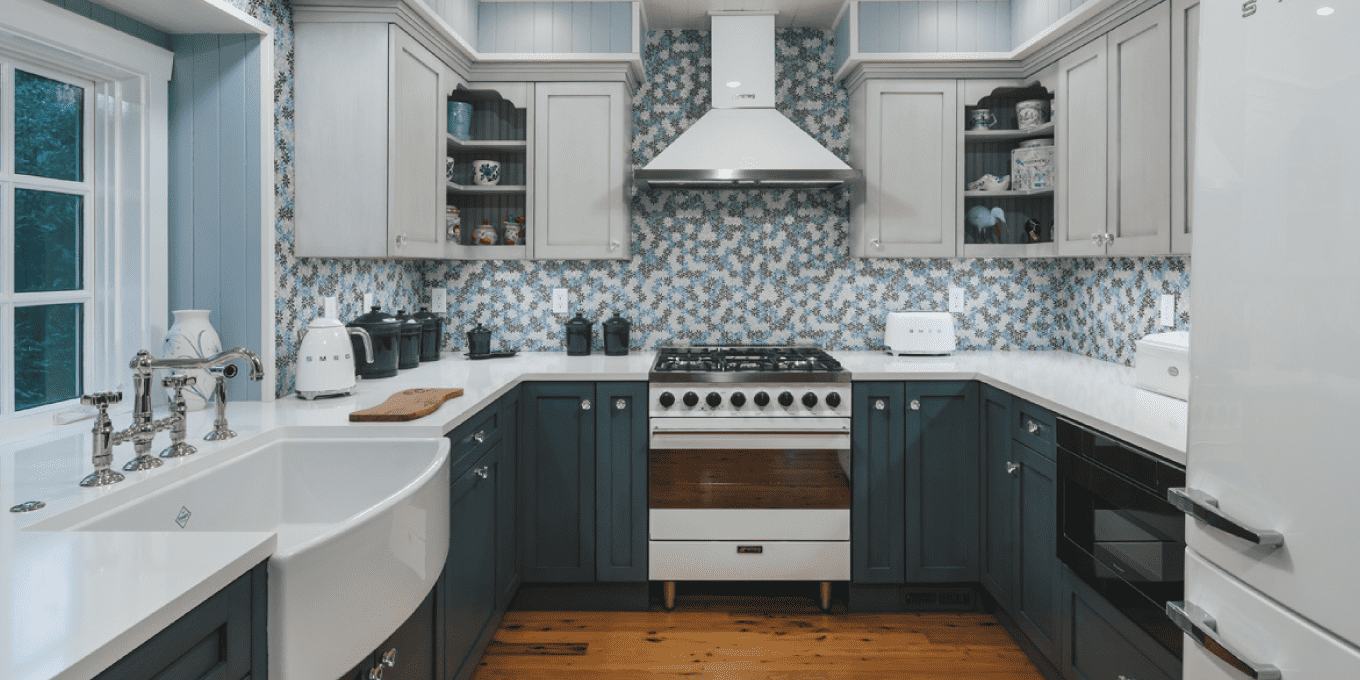When it comes to home improvement, small kitchen remodeling can be one of the most rewarding projects you undertake. It’s not just about making your kitchen prettier; it’s about transforming a cramped space into something functional, inviting, and aesthetically pleasing. This comprehensive guide will walk you through everything you need to know about remodeling a small kitchen, ensuring that every inch counts.
Understanding Your Space and Needs
Evaluating Your Current Kitchen Layout
Before diving into a small kitchen remodeling project, take a good look at your current setup. What works? What doesn’t? Assess the flow of your kitchen: the triangle between your stove, sink, and refrigerator should be compact enough to make cooking easy but spread out enough to avoid a cramped feeling. Take note of any areas that feel particularly problematic, whether it’s lack of counter space or inadequate storage.
Defining Your Remodeling Goals
What’s your primary aim in remodeling? Are you looking to increase functionality, boost your home’s value, or just make the space look nicer? Setting clear goals for your small kitchen remodeling project will help guide your decisions and keep the project on track.
Setting a Budget
The budget is perhaps the most crucial part of planning your small kitchen remodeling. Costs can escalate quickly, so it’s essential to define what you can spend and stick to it. Remember, even small changes can have a big impact. Plan for unexpected expenses by setting aside 10-20% of your budget for unforeseen costs.
Design Principles for Small Kitchens
Utilizing Vertical Space
In a small kitchen, think vertical. Tall cabinets that reach the ceiling can hide clutter and maximize storage space. Open shelving, if kept tidy, can also create an illusion of more space and allow for easy access to everyday items.
Choosing the Right Color Scheme
Color can profoundly affect how big your kitchen feels. Light colors make a room feel bigger and brighter, as they are more reflective, making the space feel open and airy. Adding a bold color can bring energy to a small kitchen remodeling project but use them sparingly to avoid overwhelming the space.
Incorporating Efficient Lighting
Good lighting is crucial in small kitchen remodeling. Under-cabinet lighting, pendant lights, and effective spot lighting can illuminate your workspace and make the kitchen more welcoming. Try to enhance natural light wherever possible—perhaps by adding a mirror or using glossy cabinet fronts to reflect the daylight.
Space-Saving Kitchen Layouts
Galley Kitchens
The galley layout, with its parallel counters, is highly efficient for small spaces. Everything you need is within reach, which can significantly streamline cooking and preparation in a small kitchen remodeling.
U-Shaped Kitchens
A U-shaped kitchen maximizes cabinet and counter space on three walls, providing plenty of storage and workspace. This layout works well in a slightly larger kitchen and can often accommodate a small dining area at one end.
L-Shaped Kitchens
The L-shaped kitchen offers a good workflow with its compact triangle. It’s ideal for adding dining spaces and can be a great way to include a small island if space permits. This layout is versatile and a popular choice in small kitchen remodeling.
Smart Storage Solutions
Innovative Cabinet Designs
Think beyond standard cabinets. Options like pull-out cabinets, lazy Susans, and appliance garages are particularly beneficial in small kitchen remodeling. They make it easier to access what you need and keep clutter off the countertops.
Hidden and Multi-Use Features
In a small kitchen, every item should have a purpose, and if it can serve multiple purposes, even better. Consider foldable table inserts, retractable range hoods, and appliances that can be tucked away when not in use.
Open Shelving and Hanging Storage
While open shelving needs to be organized to look good, it can also serve as a place to display decorative items alongside everyday dishes, adding style and personality to your kitchen. Hanging pots and pans can be functional and decorative elements, freeing up cabinet space.
Choosing Materials and Finishes
Countertop Materials
When selecting countertops, look for materials that blend aesthetics with functionality. Quartz, granite, and laminate are popular choices in small kitchen remodeling because they offer a variety of looks and durability at different price points.
Flooring Options
Flooring should be durable and easy to clean. Vinyl, laminate, and ceramic tiles are great choices for small kitchens because they’re available in many styles and are cost-effective. Lighter flooring can also make the space appear larger.
Backsplash and Wall Finishes
A stylish backsplash can serve as a focal point in your small kitchen remodeling. Choose materials that are easy to clean and maintain, like ceramic tile, stainless steel, or glass. These materials can reflect light and add a sense of depth to your kitchen.
Essential Appliances and Fixtures
Selecting Appliances for Small Kitchens
Opt for compact, multi-function appliances that conserve space without sacrificing functionality. Consider appliances that can be integrated into cabinetry for a seamless look in your small kitchen remodeling.
Choosing Sinks and Faucets
Space-saving sink designs include deep, single-basin models or small-scale double-basin options. Stylish yet functional faucets with pull-out sprayers or touchless technology can make kitchen tasks easier and help keep the area clean.
Upgrading Lighting Fixtures
Modern, efficient lighting fixtures can transform the space visually and energetically. Choose designs that complement your kitchen’s decor while providing ample light. Consider layering different types of light fixtures for maximum impact and functionality in your small kitchen remodeling.
DIY Versus Professional Remodeling
When to DIY
DIY can be cost-effective for small projects, like painting or simple hardware updates. If you’re handy and have the right tools, you can take on more substantial parts of your small kitchen remodeling project, like installing a backsplash or updating light fixtures.
Hiring Professionals
For structural changes, major electrical or plumbing updates, and high-quality cabinet installation, it’s wise to hire professionals. They can ensure the work is done safely and up to code, which is particularly important in a small kitchen remodeling project.
Cost Comparison
Understand the costs associated with both DIY and professional work. While DIY can save labor costs, professional work often means quicker completion and potentially higher quality results, which can be a significant advantage in small kitchen remodeling.
Managing Your Remodeling Project
Planning and Timelines
Create a detailed plan with a realistic timeline. Start by setting a schedule that outlines all major activities, from demolition to the final touches. This helps manage expectations and can reduce stress throughout the project.
Dealing with Limited Kitchen Access
Prepare for limited access to your kitchen during the remodel. Set up a temporary kitchen space if possible, and plan for simple meals that don’t require extensive cooking. This can ease the inconvenience during your small kitchen remodeling.
Ensuring Quality and Compliance
Ensure all necessary permits are obtained and that all work meets local building codes. Regular quality checks throughout the project can help catch issues early, ensuring your small kitchen remodeling meets both your standards and regulatory requirements.
Latest Trends in Small Kitchen Remodeling
Technology Integrations
Incorporating technology can greatly enhance the functionality of your kitchen. From smart appliances to charging stations, these additions are becoming increasingly popular in small kitchen remodeling.
Eco-Friendly Remodeling
Using sustainable materials, choosing energy-efficient appliances, and employing green building techniques can all reduce the environmental impact of your remodel while often saving you money in the long run.
Bold Design Moves
Don’t be afraid to make a statement with your small kitchen remodeling, even in a small space. Whether it’s a bright backsplash or a unique light fixture, these elements can add a lot of personality and transform the overall feel of your kitchen.
Frequently Asked Questions (FAQs)
FAQ 1: How much does a small kitchen remodel cost?
Answer: The cost of a small kitchen remodel can vary widely, depending on the materials chosen, the complexity of the layout, and whether you’re doing DIY or hiring professionals. On average, a small kitchen remodels might cost anywhere from $5,000 for minor updates to $20,000 or more for high-end materials and professional work.
FAQ 2: How can I make my small kitchen look bigger?
Answer: To make a small kitchen appear larger, use light colors for cabinets, walls, and countertops to reflect more light and give an airy feeling. Opt for sleek, compact appliances, and consider open shelving or glass-front cabinets to open up the space. Effective lighting and minimalistic designs also help create the illusion of space.
FAQ 3: What’s the best layout for a small kitchen?
Answer: The best layout depends on your space, but generally, galley or L-shaped kitchens are ideal for small spaces. These layouts maximize efficiency and storage while minimizing unnecessary movement, making them functional and space-efficient.
FAQ 4: Are there specific appliances for small kitchens?
Answer: Yes, there are many appliances designed specifically for small spaces. Compact dishwashers, smaller ovens, and narrow refrigerators are all available. You can also find multi-functional appliances, like a microwave that doubles as a convection oven.
FAQ 5: What are the best storage solutions for a small kitchen?
Answer: To maximize storage in a small kitchen, utilize multi-functional furniture and accessories. Consider using pull-out cabinets, corner drawers, and overhead storage. Magnetic knife racks, pot racks, and under-the-sink organizers can also help free up counter and cabinet space.
FAQ 6: What is the best flooring for a small kitchen?
Answer: Durable, easy-to-clean materials like vinyl, laminate, or ceramic tiles are best for small kitchens. Light-colored flooring can make the space seem larger and more open, while dark floors can add a touch of sophistication and depth.
FAQ 7: How long does a small kitchen remodel take?
Answer: The duration of a small kitchen remodel can vary from a few weeks to a couple of months, depending on the extent of the work and any custom orders like cabinetry. Simple cosmetic updates may take less time, whereas structural changes that require plumbing and electrical work can extend the timeline.
FAQ 8: Do I need a permit to remodel my small kitchen?
Answer: In most cases, yes, especially if your remodel involves structural changes, plumbing, or electrical work. It’s best to check with your local building department to understand the specific requirements for your area.
FAQ 9: Can I remodel a small kitchen on a tight budget?
Answer: Absolutely! Focus on changes that make a big impact, such as painting cabinets or switching out hardware. Consider refinishing existing materials and shopping for deals on appliances. Doing some of the work yourself can also cut costs significantly.
FAQ 10: What should I prioritize when remodeling a small kitchen?
Answer: Prioritize changes that improve functionality and maximize space. Efficient storage solutions and appropriate appliance sizes should be at the top of your list. After functionality, consider aesthetic updates that make the space feel welcoming and cohesive.
Conclusion
Remodeling a small kitchen is an opportunity to create a space that’s both functional and beautiful, no matter the size. With careful planning, the right design choices, and thoughtful consideration of your needs, your small kitchen remodeling can significantly enhance your home’s appeal and functionality. So start planning, get inspired, and transform your small kitchen into a space you love to be in.







